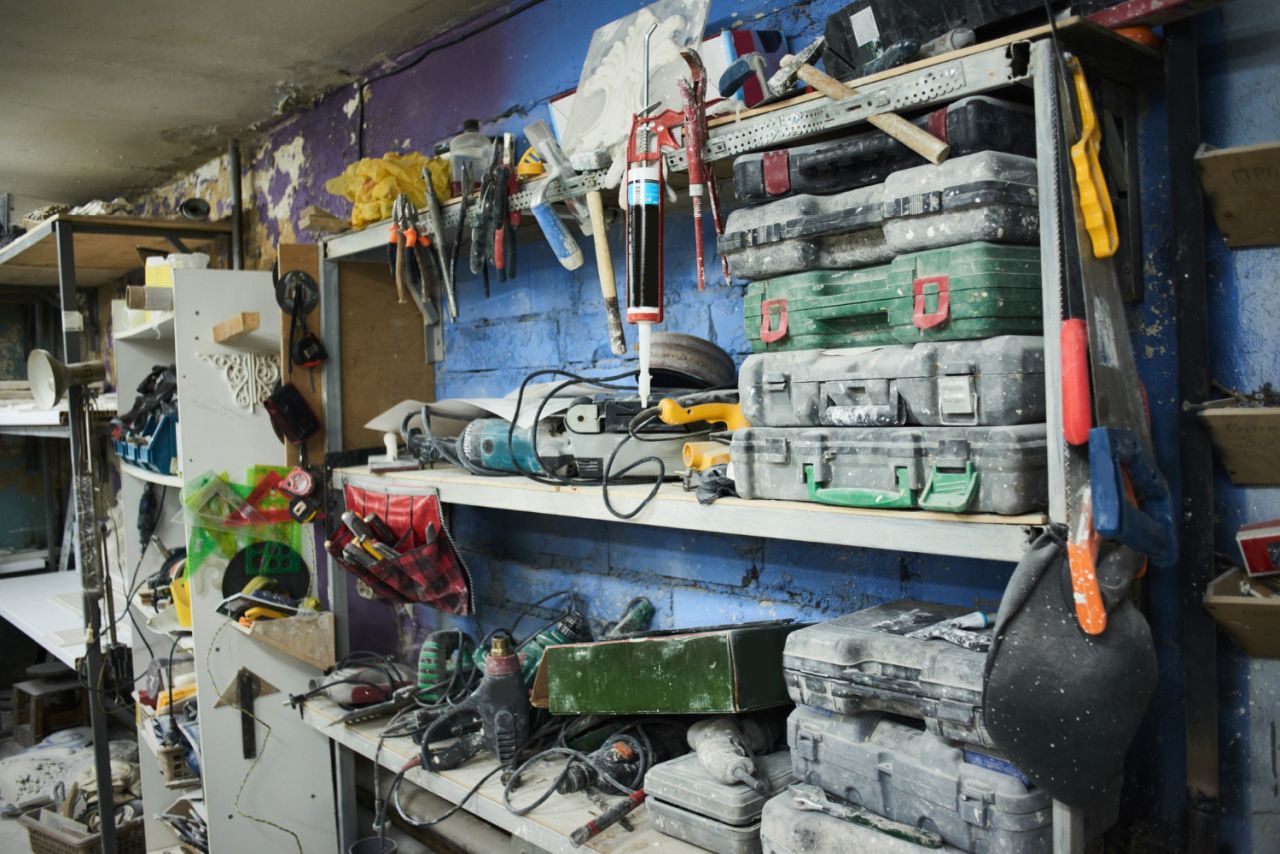When it comes to painting, whether you're working on a large-scale renovation project or simply touching up a room, proper storage solutions and organisation of your painting supplies can make a big difference.
It will help you find everything you need quickly and ensure your supplies remain in good condition for future use.
Let's Get Straight to the Point
Properly storing and organising paint supplies is crucial for maintaining their quality and ensuring safety. Start by selecting a dry, cool, well-ventilated space, such as a utility room, laundry room, or garage storage area, with shelving units for easy access.
Organise supplies by category (e.g., paintbrushes, spray paint cans, painter’s tape) and label paint cans with their colour and type to quickly identify leftover paint for reuse. Clean and store tools like brushes and rollers in mason jars or containers, keeping spray paint cans upright and away from heat sources.
Ensure good ventilation and store paint away from flames for safety. Use vertical shelving, wall-mounted storage systems, and overhead racks to maximise space. Regularly check and rotate supplies to avoid waste and keep everything in top condition.
Proper disposal of old paints, especially hazardous oil-based ones, is essential, so use local disposal programs or recycling centres when necessary. This system will ensure your supplies stay organised and safe, ready for future projects.
Choosing the Right Storage Space
Before you begin organising your paint supplies, selecting an appropriate storage space is important. The ideal location should be dry, cool, and well-ventilated. Avoid storing your supplies in areas prone to extreme temperatures, like attics or garages, without climate control.
1. Utility Room or Laundry Room
A utility room or laundry room can be an excellent storage solution for paint supplies. These areas typically have shelves or cabinets that can accommodate larger items like paint cans and brushes. Additionally, storing your paint supplies in a dedicated space ensures they remain easily accessible and organised for future projects.
2. Tool Room or Garage
A tool room or garage storage setup may offer the required space for those with a larger collection of paint supplies, such as multiple sizes of paint cans or tools for various painting projects. This is especially true if you have the space to install shelving units or wall-mounted storage systems. In this environment, you can easily separate spray paint cans, brushes, painter's tape, and other supplies by category, making it easier to grab what you need.
Organising Paint Supplies
Once you have chosen the right storage space, it's time to organise your painting supplies. A well-organised system will not only save time during your painting projects but will also extend the lifespan of your tools.
1. Grouping by Category
The first step in organising your paint supplies is grouping similar items. For example, keep all paintbrushes in one area and spray paint cans in another.
It's also a good idea to store other painting supplies in separate containers, such as painter's tape, drop cloths, and construction adhesives. This way, you can easily locate everything when it's time to start a new project.
2. Labelling Cans
Labelling your paint cans is an effective way to keep your supplies organised. Label each can with the paint colour, type (e.g., latex paint), and the room or surface used.
This will help you easily identify leftover paint cans and decide whether to store or dispose of them. You can also use a label template to ensure consistency across your entire paint collection.
3. Storing Leftover Paint
Leftover paint is common after finishing a painting project. Store leftover paint in a cool, dry place to prevent it from drying out. Ensure the lids of the cans are sealed tightly, and place them upside down for an extra layer of protection.
Smaller cans of paint are easier to store and can be placed on the bottom shelf of your storage area, while larger cans should be placed in an area that can support their weight.
Storing Paint Tools and Accessories
Organising and storing your paint tools and accessories effectively is just as important as storing the paint itself. Keeping your brushes, rollers, and other tools in good condition ensures they will be ready for use when needed.
1. Storing Brushes and Rollers
Paint brushes should be thoroughly cleaned after each use to prevent paint from hardening on the bristles. Brushes should be stored by hanging them from hooks or placing them in mason jars for easy access.
For rollers, consider using a storage container or a hanging rack. To keep everything organised, you can also store smaller brushes and accessories on shelving units or inside plastic storage bins.
2. Spray Paint Cans
Spray paint cans should be stored upright and away from heat sources. To prevent combustion, they should be kept in a well-ventilated area. Store these cans in a designated part of your shelving unit, separate from other paint supplies.
For safety, ensure the spray paint cans are stored away from potential flame hazards, such as water heaters or the garage’s back wall.
3. Painter’s Tape and Other Small Supplies

Items such as painter's tape, drop cloths, and other smaller accessories should be stored in clear plastic bins or containers. Keeping these items in separate sections will ensure they aren't mixed with your paint cans.
For easy accessibility, place the most frequently used supplies on the top shelf, while less commonly used items can go on the bottom shelf.
Safety Precautions for Paint Cans and Spray Paint
While storing your painting supplies safely is important, so is taking precautions to protect yourself and your family. Paint and spray paint cans contain chemicals that can pose health risks if improperly handled.
1. Ventilation and Fire Safety
Ensure that the space where you store your paint supplies is well-ventilated. This is particularly important for spray paint, as the fumes can be harmful when inhaled. To minimise the fire risk, avoid storing paint cans near sources of heat or open flames.
Always store them in a cool, dry area away from the water heater or any other appliances that might cause them to ignite.
2. Disposal of Old Paint Cans
Old paint cans can accumulate over time, particularly if unused. It's important to dispose of old paint safely to avoid environmental harm and clutter in your storage area.
Many local councils offer designated drop-off points for hazardous materials such as old paint cans. Check with your local council or paint stores for paint recycling programs.
3. Keeping Paint Supplies Out of Reach of Children
If you have children, always store paint and spray paint cans in an area they can access.
This could mean placing them on high shelves or inside locked cabinets. It's also important to keep other paint supplies, such as brushes and painter’s tape, organised and out of reach to avoid accidents.
Maximising Storage Space
Maximising your storage space is key to keeping your painting supplies organised. Whether you have a small room or an entire garage to work with, there are several ways to use vertical space and make the most of your available area.
1. Installing Shelving Units
Shelving units are a great idea for maximising vertical space. By building shelves along the walls of your utility room, laundry room, or tool room, you can keep your paint cans, brushes, and other supplies organised and easily accessible.
Install shelves at different heights to store large cans of paint and smaller tools, such as brushes or spray paint cans. For extra organisation, consider adding dividers or labelled bins for small items.
2. Using Storage Bins
Storage bins are another useful tool for organising smaller items like brushes, painter’s tape, and cleaning supplies. Label each bin and stack them on shelving units to create a more organised storage area.
For additional space, opt for transparent bins to make it easy to identify what’s inside.
3. Overhead Storage
If you have a garage or tool room with enough clearance, overhead storage racks can be an excellent way to store larger cans or bulky items. Use this space for less frequently used items while keeping your more commonly used supplies at eye level for convenience.
Maintaining Your Paint Supply Storage
Once your supplies are organised, it's essential to maintain your storage system. Regularly check your paint cans to ensure they are sealed properly and haven’t dried out.
Also, keep track of the quantity of paint and supplies you have so you don’t overstock or run out mid-project.
1. Periodic Checks
Periodically inspect your paint cans for damage or leaks. Ensure all cans are tightly sealed and there are no holes or cracks.
If you notice that a can is damaged, dispose of it properly. Similarly, check your brushes and other tools for wear and tear and clean them to prolong their life.
2. Rotation System
Implement a rotation system to avoid accumulating old paint supplies you no longer use. Keep track of when you purchased or last used a can of paint. If it’s been a while, consider using it for smaller touch-ups or donating it if it’s still in good condition.
Disposing of Old Paint Supplies
Finally, properly disposing of old paint supplies is crucial to maintaining an organised and safe environment. Some paints, particularly oil-based paints, are classified as hazardous waste and require special disposal methods.
1. Local Disposal Programs
Check with your local council to find out about paint disposal programs in your area. Many councils offer designated days or locations for disposing of hazardous waste, such as old paint.
2. Using Leftover Paint
Before disposing of old paint, consider using it for touch-ups or smaller projects. This can help reduce waste and make the most of what you have. For leftover paint that can’t be reused, contact a local recycling centre for advice on properly dispose of it.
Frequently Asked Questions
Where Is the Best Place to Store Paint Supplies?
The best place to store paint supplies is in a dry, cool, and well-ventilated area. Utility, laundry, and tool rooms are ideal because they often have shelving or cabinets for easy organisation.
Avoid storing supplies in areas prone to extreme temperatures, such as attics or uninsulated garages.
How Can I Organise My Paint Cans to Save Space?
Organise paint cans by grouping them by type and colour, and use labelled shelves or storage bins to separate them. Store larger cans on lower shelves to support their weight, while smaller cans can be placed on the top shelves for easy access.
Using transparent storage bins will help you quickly identify the contents.
How Should I Store Leftover Paint to Keep It Usable?
To store leftover paint, ensure the can lids are tightly sealed. Place the cans upside down to create an additional seal and prevent air from entering. Store the paint in a cool, dry location, away from heat sources, to prevent it from drying out.
What Is the Safest Way to Store Spray Paint Cans?
Spray paint cans should be stored upright in a cool, dry, and well-ventilated area away from heat sources and open flames. It’s crucial to store spray paint cans in a separate section of your storage space to ensure safety and prevent accidental ignitions.
How Can I Dispose of Old Paint and Painting Supplies Safely?
Old paint cans, especially oil-based paints, should be disposed of according to local guidelines. Many councils offer hazardous waste disposal programs for paints, while unused or leftover paint can sometimes be recycled.
Always check for local paint disposal options to ensure safe and environmentally friendly disposal.





